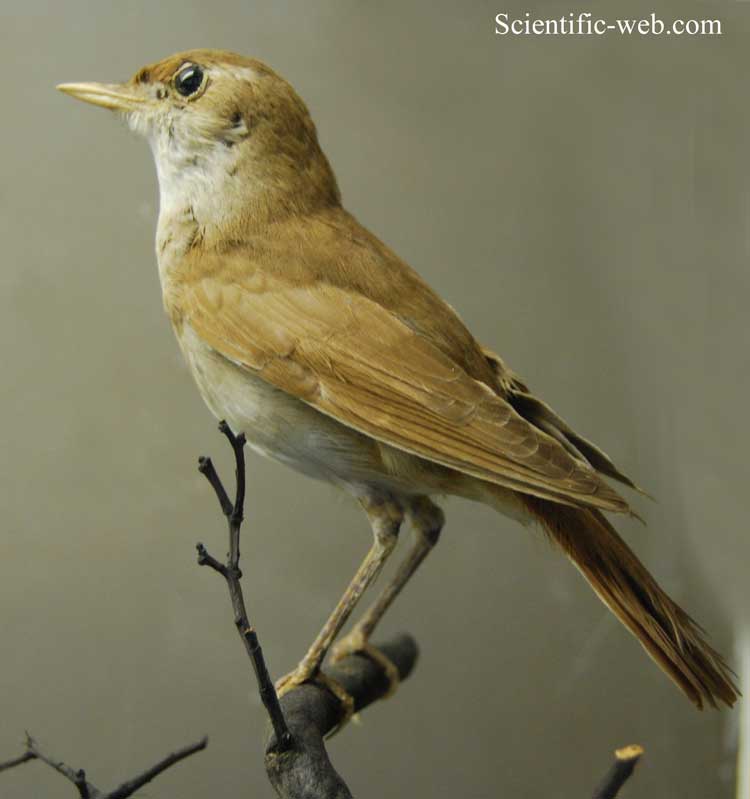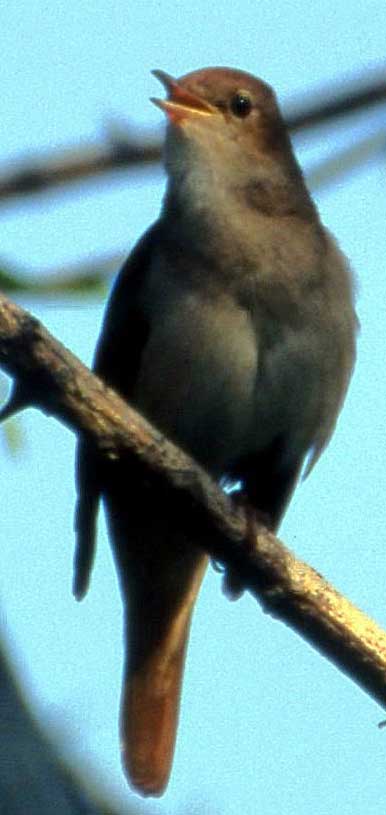Luscinia megarhynchos, Photo: Michael Lahanas Cladus: Eukaryota Name Luscinia megarhynchos (C.L. Brehm, 1831)
Luscinia megarhynchos (*)
References Handbuch der Naturgeschichte aller Vogel Deutschlands... p.356 Vernacular names The Nightingale (Luscinia megarhynchos), also known as Rufous and Common Nightingale, is a small passerine bird that was formerly classed as a member of the thrush family Turdidae, but is now more generally considered to be an Old World flycatcher, Muscicapidae. It belongs to a group of more terrestrial species, often called chats.
It is a migratory insectivorous species breeding in forest and scrub in Europe and south-west Asia, but is not found naturally in the Americas. The distribution is more southerly than the very closely related Thrush Nightingale Luscinia luscinia. It nests on the ground within or next to dense bushes. It winters in southern Africa. At least in the Rhineland (Germany), the breeding habitat of nightingales agrees with a number of geographical parameters.[2] * less than 400 m (1300 ft) above mean sea level
The nightingale is slightly larger than the European Robin, at 15–16.5 cm (5.9–6.5 in) length. It is plain brown above except for the reddish tail. It is buff to white below. Sexes are similar. The eastern subspecies L. m. hafizi and L. m. africana have paler upperparts and a stronger face-pattern, including a pale supercilium. Nightingales are named so because they frequently sing at night as well as during the day. The name has been used for well over 1,000 years, being highly recognizable even in its Anglo-Saxon form - 'nihtingale'. It means 'night songstress'. Early writers assumed the female sang when it is in fact the male. The song is loud, with an impressive range of whistles, trills and gurgles. Its song is particularly noticeable at night because few other birds are singing. This is why its name includes "night" in several languages. Only unpaired males sing regularly at night, and nocturnal song is likely to serve attracting a mate. Singing at dawn, during the hour before sunrise, is assumed to be important in defending the bird's territory. Nightingales sing even more loudly in urban or near-urban environments, in order to overcome the background noise. The most characteristic feature of the song is a loud whistling crescendo, absent from the song of Thrush Nightingale. It has a frog-like alarm call. Symbolism The nightingale is an important symbol for poets from a variety of ages, and has taken on a number of symbolic connotations. Homer evokes the Nightingale in the Odyssey, suggesting the myth of Philomela and Procne (one of whom, depending on the myth's version, is turned into a nightingale[3] ).[4] This myth is the focus of Sophocles' tragedy, Tereus, of which only fragments remain. Ovid, too, in his Metamorphoses, includes the most popular version of this myth, imitated and altered by later poets, including Chrétien de Troyes, Geoffrey Chaucer, John Gower, and George Gascoigne. T.S. Eliot's "The Waste Land" also evokes the Nightingale's song (and the myth of Philomela and Procne).[5] Because of the violence associated with the myth, the nightingale's song was long interpreted as a lament. The Nightingale has also been used as a symbol of the poet or their poetry.[6] Poets chose the nightingale as a symbol because of its creative and seemingly spontaneous song. Aristophanes' Birds and Callimachus both evoke the bird's song as a form of poetry. Virgil compares a mourning Orpheus to the “lament of the nightingale”.[7] During the Dark Ages fewer references were made to the nightingale. John Milton and others of the 17th century renewed the symbol. In "L'Allegro" Milton characterizes Shakespeare as a nightingale warbling “his native woodnotes wilde” (line 136), and Andrew Marvell in his "On Paradise Lost" subsequently described Milton's Paradise Lost in similar terms: "Thou sing'st with so much gravity and ease, During the Romantic era the bird's symbolism changed once more: poets viewed the nightingale not only as a poet in his own right, but as “master of a superior art that could inspire the human poet”.[8] For some romantic poets, the nightingale even began to take on qualities of the muse. Coleridge and Wordsworth saw the nightingale more as an instance of natural poetic creation: the nightingale became a voice of nature. John Keats' "Ode to a Nightingale" pictures the nightingale as an idealized poet who has achieved the poetry that Keats longs to write. Invoking a similar conception of the nightingale, Shelley wrote in his “A Defense of Poetry": "A poet is a nightingale who sits in darkness and sings to cheer its own solitude with sweet sounds; his auditors are as men entranced by the melody of an unseen musician, who feel that they are moved and softened, yet know not whence or why.”[9]
* John Keats's "Ode to a Nightingale" has been described as "one of our shorter English lyrics that still seems to me... the nearest to perfection, the one I would surrender last of all"[10] and "one of the final masterpieces of human work in all time and for all ages".[11]
* In series 8 of the British spy drama Spooks, the spooks try to stop an organization called Nightingale which is planning to make a war break out between India and Pakistan to prevent a future where the Taliban would take control of Pakistan and its nuclear arsenal.
1. ^ BirdLife International (2004). Luscinia megarhynchos. 2006. IUCN Red List of Threatened Species. IUCN 2006. www.iucnredlist.org. Retrieved on 12 May 2006. Database entry includes justification for why this species is of least concern Source: Wikispecies: All text is available under the terms of the GNU Free Documentation License |
|


